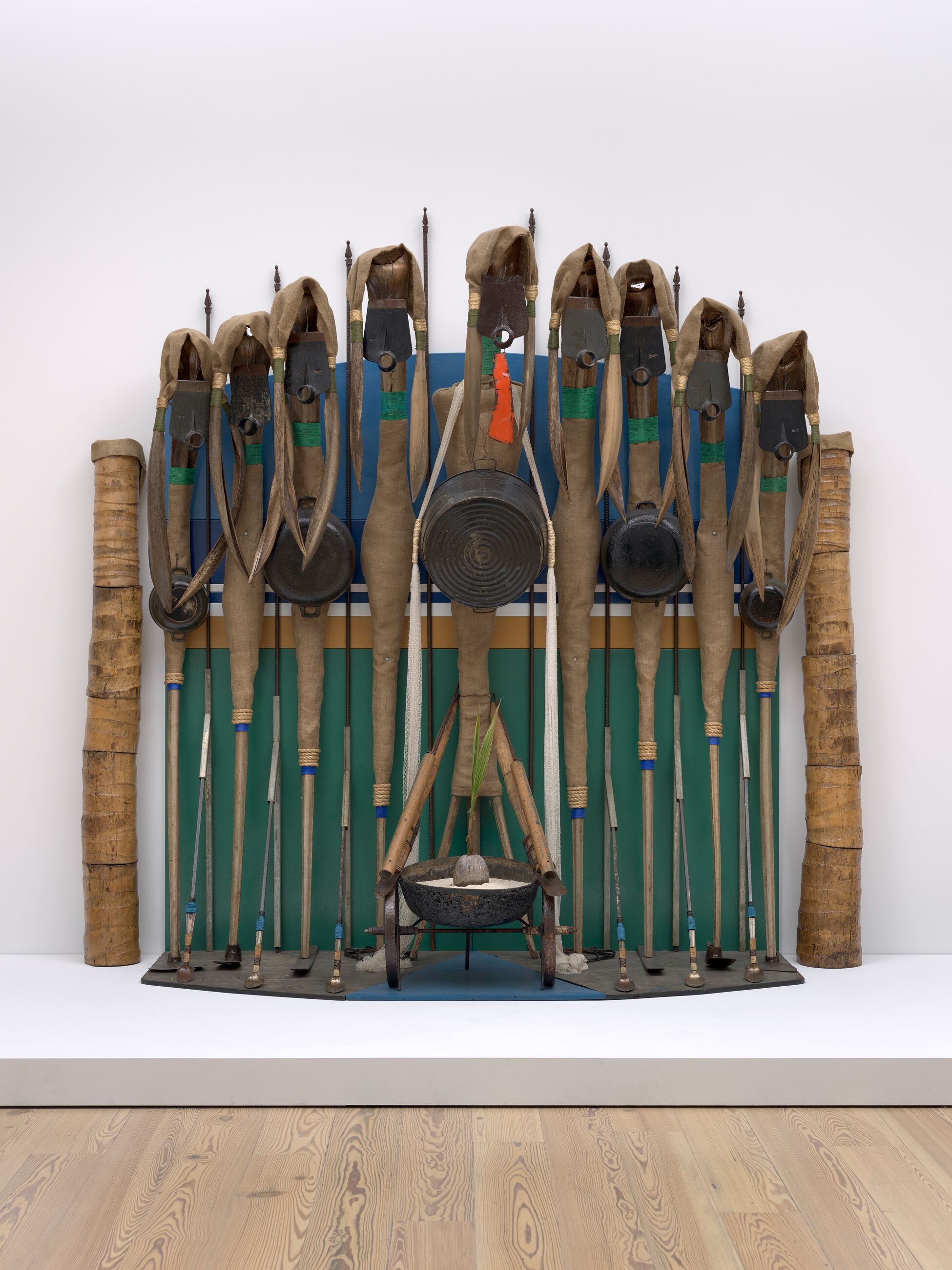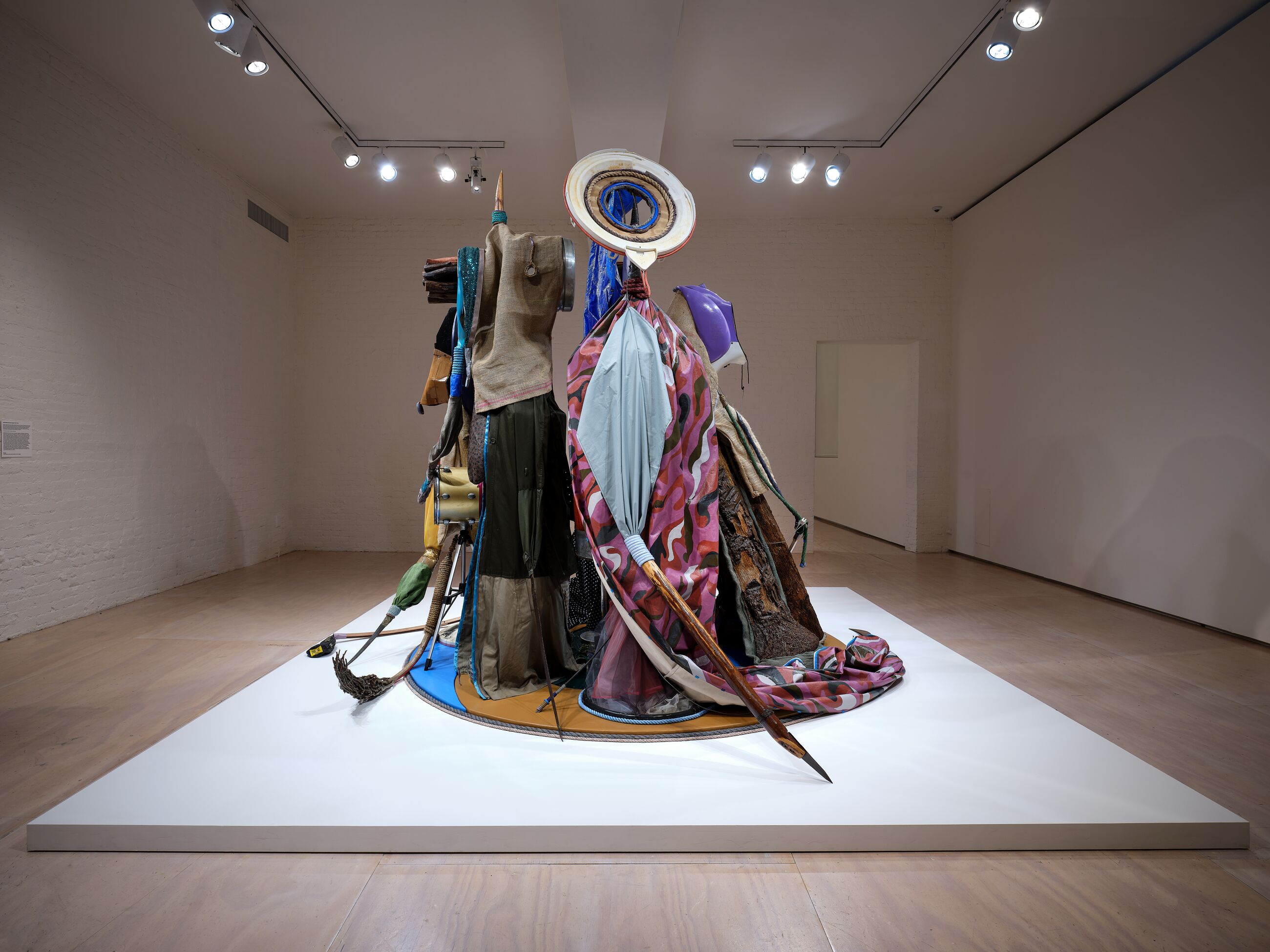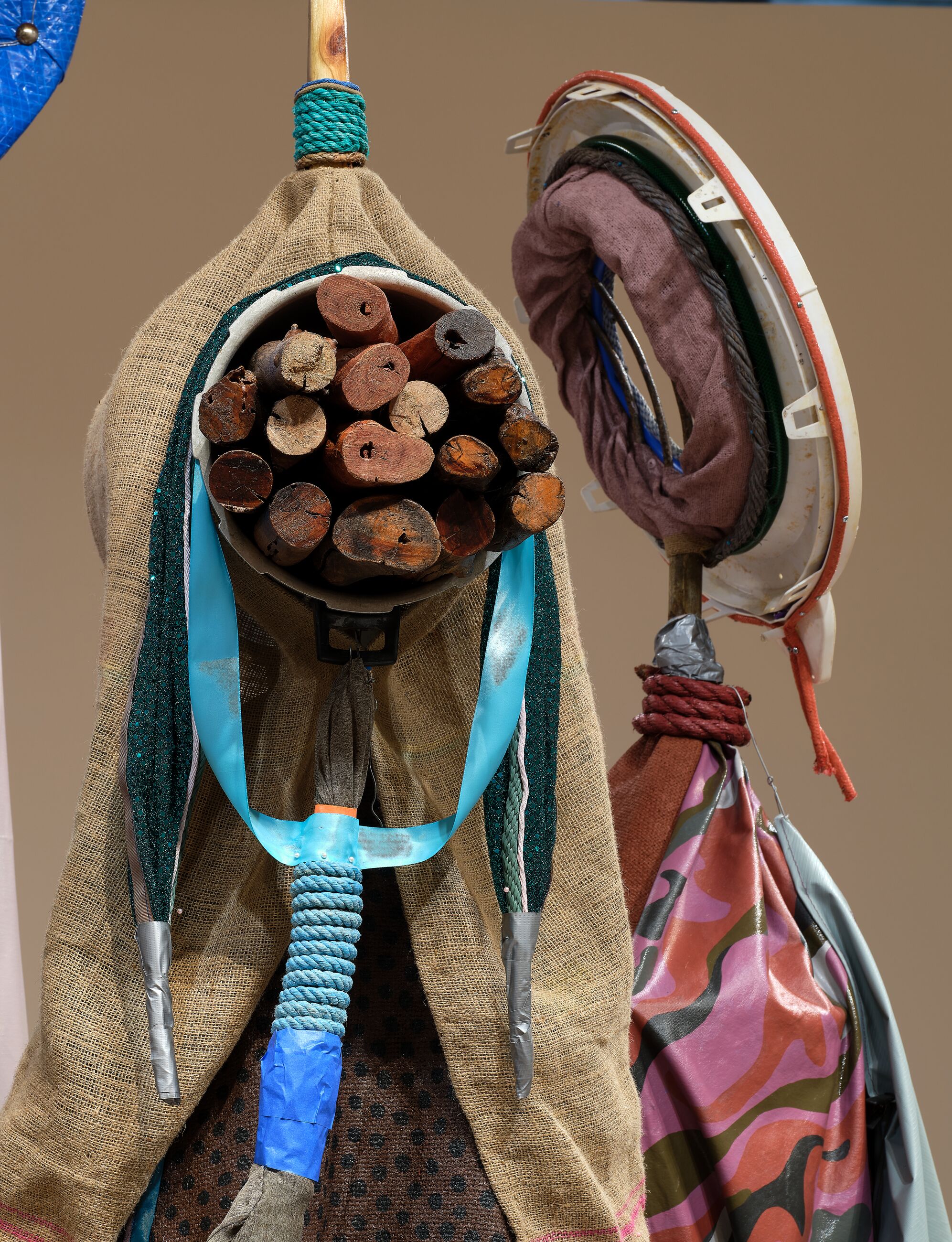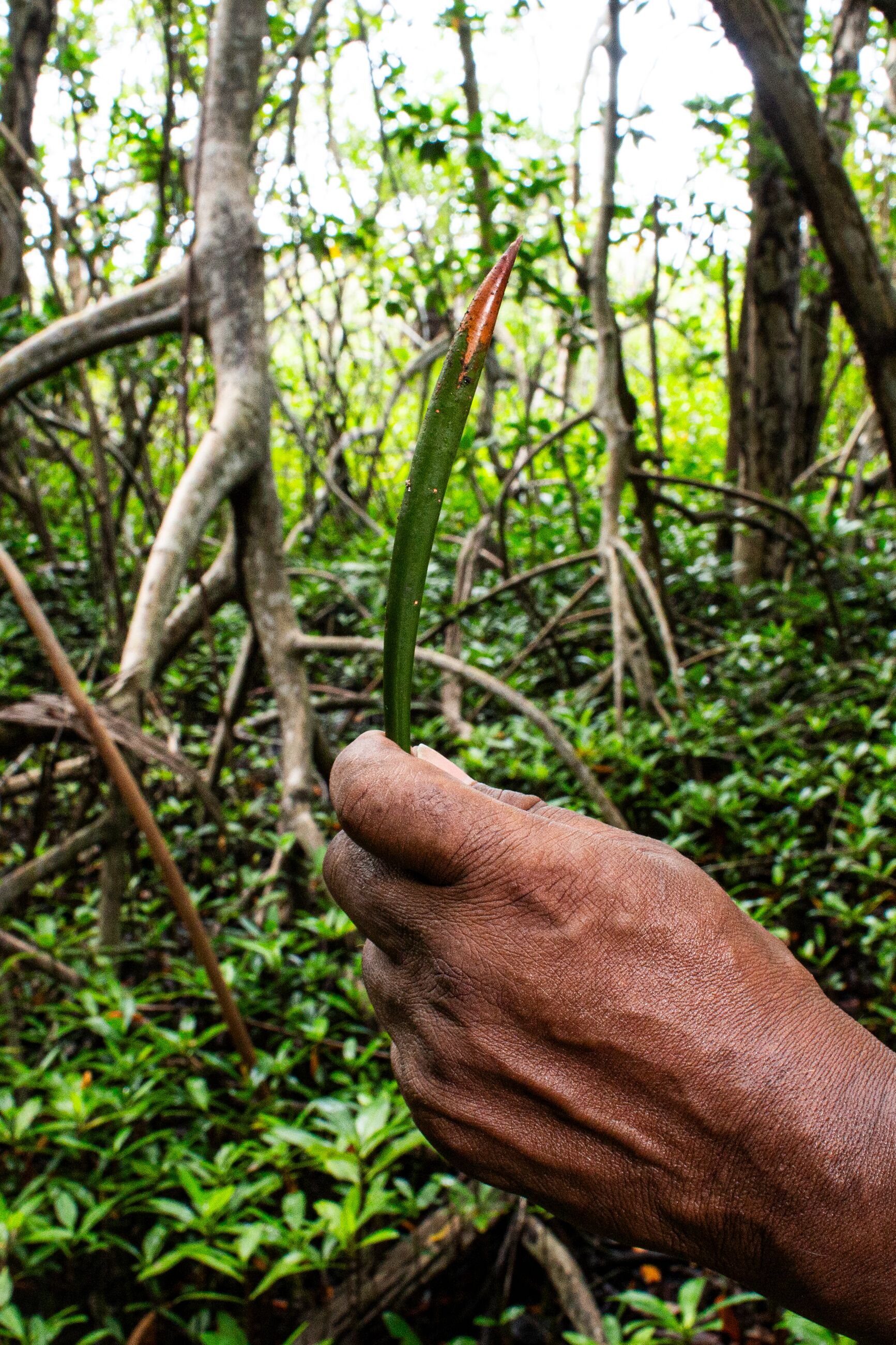Essays
We Are Landscapes
On Daniel Lind-Ramos’s assemblages and Puerto Rico’s endangered mangrove ecosystem
By Steve Maldonado Silvestrini

Daniel Lind-Ramos, Centinelas (Sentinels), 2013 © Daniel Lind-Ramos. Courtesy Whitney Museum of American Art, New York. Photo: Ron Amstutz
The convergence of worlds in the sculpture of Daniel Lind-Ramos invites other worlds to emerge. The objects he uses to make his pieces—found, purchased, exchanged, rescued or gifted—come imbued with sacred energy and memories, and they tell individual and collective stories of the Afro-Caribbean experience. Lind-Ramos honors these artifacts and their former keepers by preserving their histories in his assemblage-altars. A recurring theme in his work is the depiction of the Black militias that countered—and defeated—the English army during the invasion of Puerto Rico in 1797. The farmers, charcoal burners and fishermen who confronted the incoming troops fought with what they had on hand, their everyday tools, using the cover of night and mangrove thickets as valuable allies. Their defense was born of loyalty not to the Spanish crown but to their homeland. Despite their success, attempts have been made over the centuries to alter, erase and whitewash their contribution.
In Lind-Ramos’s assemblage Centinelas (Sentinels) (2013), a uniformed, almost homogeneous, militia composed of hoe faces, burlap torsos, iron limbs, rope joints and cauldron shields stands evenly spaced between two coconut palm trunks, the columns of a portico. The soldiers are defending the entrance to their territory, a landscape suggested by a chromatic background: a dark-blue sea and light-blue sky, white waves on a sandy coastline and a green mangrove forest. In the center of the formation, a figure holds the reins of a cart carrying a germinating coconut atop a bed of sand. This is the fighters’ true flag—what they care for, defend and fight for, and what will mirror their efforts. The coconut palm’s fruits, stalks and trunks provide nutritional, economic, material, spiritual and cultural sustenance to their community.

In thinking about the career of Lind-Ramos—born in 1953 in Loíza, a small coastal town east of San Juan, where he lives and works to this day—it’s important to take both site and temporality into consideration. In Puerto Rico, the word “temporal” suggests not only time but also hurricanes and tempests, storms that are nature’s method of defense and renewal.
Hurricane Maria in 2017 represented a substantial upheaval for Puerto Rico, devastating but at the same time revealing, lifting veils and reigniting nearly-extinguished fires. The aftermath yielded a contemporary resurgence of decolonizing traditions, one of which was bomba, a musical and dance style that originated in the archipelago, a means for expressing both joy and grievance. In bomba, a piquete—one of the improvised dance steps performed in rhythm with the instruments—represents lightning, while the responsive drumming is the accompanying thunder.
One of the figures in Lind-Ramos’s assemblage Centinelas de la luna nueva (Sentinels of the New Moon) (2022–23)—which functions as a performance of sorts, involving five characters—plays a drum, issuing both percussive warning and war cry. He doesn’t use bomba’s traditional barrel drum, but instead what he found available around him. Another figure in the sculpture sweeps a broom made from the dried inflorescences of the coconut palm. The broom doubles as a weapon: It not only removes dirt from a house but also cleanses it of invaders. Historically used for domestic work by impoverished women, the palm broom is also integral to the character of La Loca, who prepares the way for processions during the Festival de Santiago Apóstol.

Daniel Lind-Ramos, Centinelas de la luna nueva (Sentinels of the New Moon), 2022–23. Photo: Argenis Apolinario
In the sculpture, the trunks and roots of the palms that nourished centuries-old ancestors now make up the body of a descendant. If we are what we eat, then we are landscapes.
Each of Lind-Ramos’s objects carries multiple meanings. Together, the elements form archetypal characters that can change roles without altering their costumes. Referencing Loíza’s traditional carnival in Sentinels of the New Moon, he presents the character of El Viejo, the old man, with a typical cardboard mask. The mask’s mirror-mouth serves as a portal to ancestors and also reflects away negative and unwanted energies. El Viejo’s head is crowned with an ocean halo, featuring ears that are part of the design of a blue land-crab trap. With these ears, the figure captures stories to share later.
A tripod indicates that the legs of the figures in the assemblage are roots, deeply entrenched, difficult to unearth. Several rebars continue the construction of this accumulation, which also functions as a representation of a mangrove forest, a vital part of the Puerto Rican ecosystem. In the sculpture, the trunks and roots of the palms that nourished centuries-old ancestors now make up the body of a descendant. If we are what we eat, then we are landscapes.
Countless kinds of flora comprise mangroves, but one species is widely recognized as its hallmark. With its distinctive roots and floating propagules, the red mangrove thrives naturally in the Antilles and nearly all coasts of the Caribbean Sea. Its distribution extends into the Atlantic, reaching as far as Bermuda, the northern shores of Florida and the Gulf of Guinea in West Africa. The connection between these places is not only ecological but also sociocultural. The Caribbean is everywhere that mangroves exist.

Daniel Lind-Ramos in the mangroves in Loíza, Puerto Rico
The mangrove ecosystem has always supported numerous varieties of life. Trees and shrubs grow from the sediment trapped between their roots, while vines find structural support in their branches. Mangroves are an oasis for resident and migratory species, especially birds who find in them a safe place to rest, feed and raise their chicks. The network of roots is also a nursery for numerous juvenile species of fish, crustaceans and mollusks, which find protection from predators within it.
For coastal Caribbean communities, the resources provided by mangrove forests have been plentiful. The roots and wood of the trees—harvested during the last quarter of the moon, just before the new or black moon—are used to construct fish traps and houses. So-called black wood, produced from black-olive trunks cured with the salt and sludge of the mangrove, in particular benefited the community of Piñones, a neighborhood of Loíza. The wood was coveted by sugar mills for its density and was especially useful for railway infrastructure. Firewood has also been an important product of the mangrove; the skills developed for cutting and processing it have functioned as a connection among global mangrove communities. Unlike the production of black wood in Puerto Rico, the cutting and gathering of firewood has been predominantly carried out by women. In Sentinels of the New Moon, a firewood woman is present: her head is represented by a bucket of logs, and her breasts store the charcoal that will be used for cooking later. As mangroves filter the air we breathe, they also sequester carbon. By salvaging stray debris for his work, recycling what was once in limbo, Lind-Ramos acts likewise as a filter.

Daniel Lind-Ramos, Centinelas de la luna nueva (Sentinels of the New Moon) (detail), 2022–23. Photo: Argenis Apolinario
As mangroves filter the air we breathe, they also sequester carbon. By salvaging stray debris for his work, recycling what was once in limbo, Lind-Ramos acts likewise as a filter.
The mangrove is a guardian. It protects reefs by filtering the runoff and sediments that rivers bring from the mountains, effluvia that would otherwise cover and suffocate the corals. By mediating between fresh-and saltwater bodies, the mangrove regulates the pulse of erosion, preventing the land from dissolving and washing away with the tides. This pacifying seawall is now in constant conflict with the catastrophes generated by global warming. Just as it shelters species, its defenses shield us from rising sea levels as well as from stronger and more frequent floods and storms.
Mangroves were considered undesirable for sugar plantations, a situation that allowed workers to settle the areas. In the mid-16th century much of Loíza’s land was granted to the Dominican Order by the Spanish crown, but in 1837, the crown took the area back. By that time it had already developed into an Afro-Puerto Rican village, inhabited primarily by runaway and freed slaves. This community was the first to resist a forced expropriation of the land in 1848. Afterward, the area was leased to neighboring haciendas and the archipelago transitioned from Spanish to American control.
In 1918, the Piñones mangroves were designated an insular forest, providing a level of legal protection that was later expanded in 1979 when the area was declared a natural reserve by Puerto Rican authorities. But despite these safeguards, protection of the habitat remains uncertain because about half of the reserve’s land remains privately owned.


The mangroves cannot defend themselves from disaster capitalists and the effects of accelerated climate change.
The collapse of the sugarcane industry in Puerto Rico coincided with the expansion of tourism and condominium development, particularly in coastal areas such as Piñones. In 1999, the Corporación Piñones Se Integra was founded to defend both the community and the environment. It opposed a massive hotel, casino and gated-condominium project known as Costa Serena, which not only threatened the mangroves but also aimed to forcibly expropriate Piñones residents. It took until 2006 for the Serena project to be definitively halted—an effort described by Maricruz Rivera Clemente, the Corporación’s founder, as a battle fought with “a very sharpened machete.” But since that victory, local authorities have initiated ambiguous appraisal processes of the disputed lands with the supposed aim of acquiring them. No acquisition has come to pass, but some politicians and developers have used the uncertainty surrounding the land’s status to stage attempts at reviving the project.
The mangroves cannot defend themselves from disaster capitalists and the effects of accelerated climate change. Loíza residents remain vigilant, resisting systemic neglect, racism and developers who prioritize profits over environmental protection. The sentinels in Lind-Ramos’s work evoke those who work on behalf of the mangroves in Puerto Rico in the present day, asserting no distinction between themselves and the habitat. The human chains they form intertwine like the roots of these trees. The mangrove’s guardians have diversified and multiplied the tools of their defense with cleanup initiatives that focus on clogged canals and trash, along with proposals for ecological tourism and the propagation and restoration of the mangrove. Under the blackened moon, these new sentinels work to protect their heritage and sow their future.
As a young man, Lind-Ramos took part in the St. James festivities, interpreting a griot through the character of El Viejo. Griots know what has existed, what no longer exists and what the future may hold. Lind-Ramos complements this oral tradition through his drawing, painting, sculpture, assemblage and videos. In complex and revelatory ways, the storytelling embedded in his work amplifies the voice of his home, his community and his environment.
“These stories,” he says, “are as much about Loíza as they are about the world.”
–
Daniel Lind-Ramos is an artist from Loíza, Puerto Rico. His work is in the collections of the Whitney Museum of American Art, the Solomon R. Guggenheim Museum and the National Gallery of Art, among others. In 2021, he received a MacArthur Fellowship.
Steve Maldonado Silvestrini is an artist, botanist and environmental activist from Puerto Rico. He collaborates with communities, environmental organizations and scientists to protect unique natural sites in the Caribbean. His creative explorations center on future narratives, narcoculture, etymology, interspecies communication, living systems, mutualism and natural history collections.
Photography: Erika P. Rodríguez
–
Ursula Issue 13 includes a special section about the environment, as considered by a diverse group of artists, writers and activists. The section takes readers to Puerto Rico, where Daniel Lind-Ramos’s work is rooted in the Caribbean mangrove ecosystem and the dangers threatening it; to Los Angeles, where Charles Gaines has long fused conceptual sculpture and information conveying the speed at which environmental damage is occurring; around the world to see the imagery of the international movement known as Solarpunk, which promotes the power of hopeful imagination in the face of increasing climate threats; and to New York’s Healthy Materials Lab, a design research lab at Parsons School of Design radically retooling the spaces in which we live and work. The section ends with a moving essay by the artist Ross Simonini, a longtime resident of Altadena, Calif., who lost his home and his neighborhood in the recent Los Angeles wildfires.
